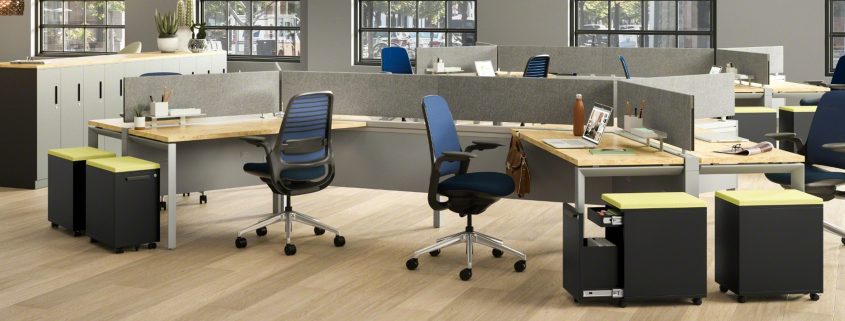Integrative Workstations Solve The Open Plan Office Dilemma
- Collaborative solutions: Grouping several desks together creates a hive that is very effective for teams and departments because it fosters partnerships and open communication.
- Reduced open-back visibility: Most open office plans situate desks lined up against walls or placed in front of the windows to maximize natural light. Although this is one of the best layouts for an open office, it is never good to have your back facing people. It’s an unsettling work arrangement. Turning the desks to face each other or into the room protects the privacy of the computer screens, especially when dealing with sensitive corporate data.
- Diverse layout options: When designing an open office plan, you should understand that it is not necessary to have the same furnishings in the entire office space. You can create private spaces and unique groupings to accommodate different needs. This is where integrating benching can be a great fit, for both meeting spaces and transitional workspaces. You can even install single soundproof booths to allow employees to make private phone calls or conference without disturbing those around them.
Giving employees a visual break from the monotony of a rigid office layout reduces workplace anxiety. Adding couches and comfortable seating around the office encourages casual connection and employee engagement. Creating a natural flow of ergonomics for meetings and impromptu gatherings
Why Integrative Workstations?
Guided by integrative workstations, creating balance within an outdated office layout is one of the first steps toward resolving not only the look of the office but the vibe. Certain departments will thrive in a cubicle environment, others will struggle to achieve their daily tasks and may spend too much time walking around walls to collaborate. Keep these ideologies in mind so your changes are not too abrupt and jarring to workflow:
Enhanced communication between employees sparks ideas, gets things done and levels the playing field of accomplishment. When an office has fewer physical barriers, communication becomes more natural, thus improving teamwork. Enhanced teamwork boosts collaboration across the board. Open office plans remain the best choice for flexible workers and creative teams who thrive in a hive of activity and constant banter. Providing opportunities to network and openly communicate is very beneficial to wellbeing, improves mentoring opportunities and solidifies teams.
Flexibility and flexible work have altered the landscape of collaboration. At first glance, a cubicle driven office plan can appear to be inflexible, but the components can provide open office environments with choices. Some tasks still require the focus that cubicles provide. As far as design goes, just like benching systems, you can convert the office to different layouts as needs change. Both systems allow quick redesigns without a large expense to the company’s budget. Blending office systems as your company continues to grow, gives you extraordinary options for a unique space that can satisfy a diverse workforce.
Increased collaboration is by far the greatest benefit of open office workspaces. When you create ease of working together your staff will be more likely to innovate, share ideas and naturally ask for input from each other. There are many web-based tools that assist with collaboration in the workplace, but encouraging person-to-person interaction with a well thought out office design is still better than virtual tools because we are social beings. Workplace productivity benefits exponentially from interpersonal communication.
Improved relationships and open communication are the hallmarks for productivity. Office systems are very effective in building relationships between the employees. Integrative workstations strike a balance between the advantages of cubicles and benching workstations. Cubicles can provide focused tasks with much needed quiet time while benching systems encourage more open collaboration. Combining the two into your office design gives you more options for the flexible work environments that attract and keep top talent. An open plan office also makes leadership more accessible and approachable, leveling the playing field by bringing all the team members to the same level of shared information.
Reducing start-up and operating costs are often a huge part of the growth process. Helping employees work harmoniously together and partner for solutions leads to innovative thinking and problem-solving. When a company is not required to construct a lot of rooms and walls, it ends up creating a hive of collaboration. Extra workspaces can be easily added when additional team members are required. Flexible office plans are also more economical when it comes to paying for heating, air conditioning, and electricity bills.
Better employee health begins with a solid foundation of collaboration and ergonomics. Studies have shown that sitting for long periods and staring at a computer all day can cause negative health effects. Adding sit/stand desks to the workspace provides a powerhouse of benefits. Open areas make a space seem larger, allow more natural light, and increase airflow, thus enhancing air quality. As a result, employee alertness and focus are increased, thus improving productivity.
On the surface, finding common ground in your workspace is a balance between temperaments, workstyles, and ways to generate productivity. Integrative workstations inspire better design within your office, which plays a pivotal role in each one of those decisions. Workstations provide an anchor for your team that enables them to perform at their best. Finding ways to integrate cubicles and benching systems is a great way to transition to a unique progressive office design. When you have good bones, all you need is the right designer to make it all come together.
 MEET TERESA ALVAREZ: Teresa is an office furniture specialist who can help your workspace become more intuitive with its design and furnishing options. With 12 years experience in the office interiors and office supply business, she can help you find creative solutions to invest an office design for the dynamic workforce of your future. Contact her via email at teresa@officefurniturenow.com or give her a call at 888-910-3769 x139.
MEET TERESA ALVAREZ: Teresa is an office furniture specialist who can help your workspace become more intuitive with its design and furnishing options. With 12 years experience in the office interiors and office supply business, she can help you find creative solutions to invest an office design for the dynamic workforce of your future. Contact her via email at teresa@officefurniturenow.com or give her a call at 888-910-3769 x139.



